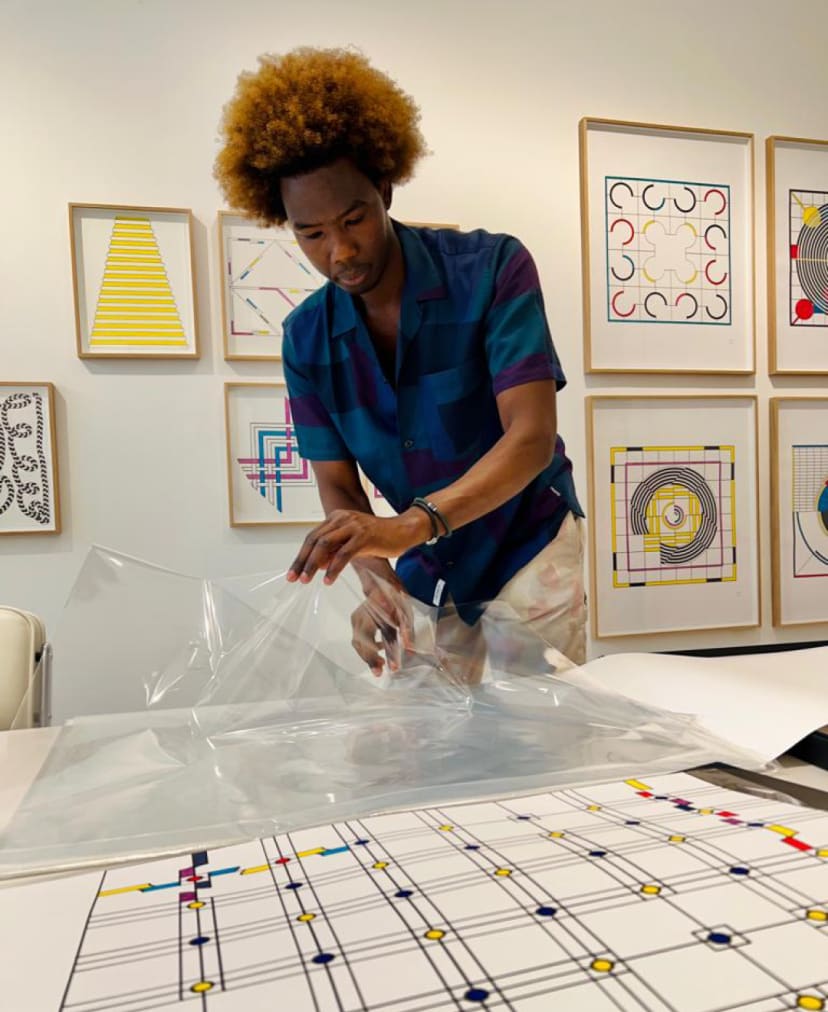Portrait Of The Artist: Linda Swann

Ahead of her new exhibition of paintings at Paul Smith Westbourne House, artist Linda Swann talks about where she gets her inspiration from (hint: everywhere) and why she’s so drawn to geometric pattern.
We often talk about taking note of the beauty in the everyday – the aesthetic equivalent of stopping and smelling the roses – but how about the patterns that surround us? We don’t usually pay much attention to the geometric shapes that make up our world – but artist and painter Linda Swann does. In fact, she can’t help it, it just something that comes naturally.
They are, of course, everywhere – and while we might think their artistic history lies somewhere in modernism (think of the work of Bridget Riley or Germany’s Bauhaus movement, for example), geometric tradition in art spans centuries and cultures. A tradition which Linda now belongs to. Her colourful, dynamic works – which draw especially on Islamic geometry – are also the subject of a new exhibition at Paul Smith Westbourne House. To mark the occasion, we asked her favoured medium, what she wants people to take away from her art and her daily routine.
Why did you become an artist?
It wasn’t so much becoming as continuing with something I’d always done and just because I was grown up why stop?
Why do you work primarily in your medium?
I discovered acrylic paint because it is easy to work with, quick drying and suits the flat matte style I use. For preparation on a small scale, I work with gouache on watercolour paper. Prior to that with pencil on paper, either cartridge or graph paper. Then I scale up a design.
Where do you find inspiration?
I see geometry all around us in the urban and natural environment. I’m fascinated by geometric pattern found in so many cultures around the world, which often interrelate.
How would you describe your work?
Geometric pattern with a strong emphasis on colour and colour relationships. Although I was initially influenced by Modernism, for example Constructivism and ‘Op art of the 1960s. I came to see what I do as working more in a tradition of geometric art that is centuries old. Often traditionally regarded disparagingly as ‘just craft’.
What do you hope people take away from your art? What are you trying to say?
I love geometric pattern; it’s absorbing in the way it constantly changes as you look at it. It also needs time, not grasped in a moment. I’m not saying anything other than ‘just look’.
How does being an artist affect your outlook on life?
It encourages me to observe more acutely the world around me and think more for myself. It’s also about personal development, the work reflects how I’ve grown in maturity.
How do you feel when you’re working? What’s going through your mind?
A lot of things, frustration mainly, if it’s not going right. So many drawings end up in the bin before I find what I want. A lot of what I do involves problem-solving and then trying to find out how on earth I can work out an idea.
Do you have a particular routine or any ‘rituals’ when you’re working?
Definitely not wearing slippers in the studio. I work at home, so I like to have dividing line somehow in what is a fairly small flat. A routine consists of doing necessary household chores in the morning to get them out the way.
What does your typical working day look like?
My chosen style of work is quite intense and very solitary. I’m in my studio most days. I like to work in fairly short, concentrated number of hours usually from the afternoon to mid-evening. At other times I’m out doing other things.
If you weren’t an artist, what would you do and why?
As a child in primary school, I discovered classical music and thought I’d like to become a professional musician. Opportunities never arose. In much later life as an amateur singer, I joined a classical music choir. I would always want to do something creative, or life would be very boring and dull.
Linda Swann's Paintings will be at Paul Smith Westbourne House from 14 June to 6 September 2023.
Click here to take a virtual tour of the exhibition.
Get Directions
Discover More

Events & Exhibitions
Henry Holland: Nobody Cares How Good You Used To Be
We visited the designer-turned-ceramicist at his studio to mark the new exhibition of his one-of-one and limited-edition pieces at Paul Smith Albemarle Street.
05.23

Events & Exhibitions
Portrait Of The Artist: Amer Musa
As the “A Big Dream” exhibition of his colourful, geometric work opens at Rue de Grenelle and Boulevard Raspail, we sat down with Amer Musa to discuss why art is therapy for him and why he feels lucky to live in Paris, a city filled with art.
05.23
Sign Up For Updates
Published: 14.06.23
Words: Molly Isabella Smith